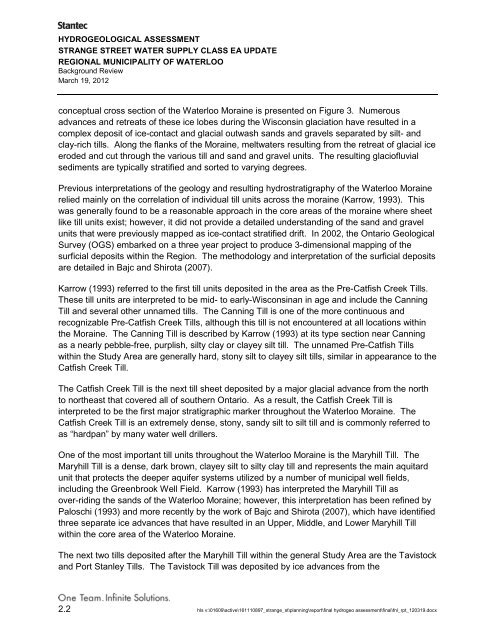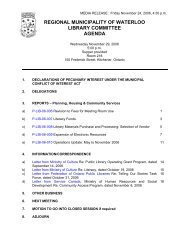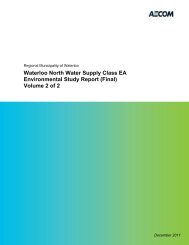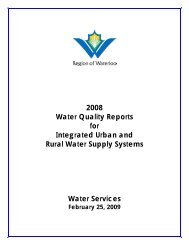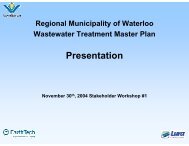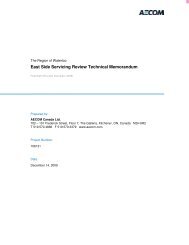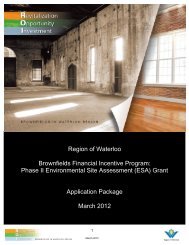Sam Ziemann From - Region of Waterloo
Sam Ziemann From - Region of Waterloo
Sam Ziemann From - Region of Waterloo
You also want an ePaper? Increase the reach of your titles
YUMPU automatically turns print PDFs into web optimized ePapers that Google loves.
HYDROGEOLOGICAL ASSESSMENTSTRANGE STREET WATER SUPPLY CLASS EA UPDATEREGIONAL MUNICIPALITY OF WATERLOOBackground ReviewMarch 19, 2012conceptual cross section <strong>of</strong> the <strong>Waterloo</strong> Moraine is presented on Figure 3. Numerousadvances and retreats <strong>of</strong> these ice lobes during the Wisconsin glaciation have resulted in acomplex deposit <strong>of</strong> ice-contact and glacial outwash sands and gravels separated by silt- andclay-rich tills. Along the flanks <strong>of</strong> the Moraine, meltwaters resulting from the retreat <strong>of</strong> glacial iceeroded and cut through the various till and sand and gravel units. The resulting glaci<strong>of</strong>luvialsediments are typically stratified and sorted to varying degrees.Previous interpretations <strong>of</strong> the geology and resulting hydrostratigraphy <strong>of</strong> the <strong>Waterloo</strong> Morainerelied mainly on the correlation <strong>of</strong> individual till units across the moraine (Karrow, 1993). Thiswas generally found to be a reasonable approach in the core areas <strong>of</strong> the moraine where sheetlike till units exist; however, it did not provide a detailed understanding <strong>of</strong> the sand and gravelunits that were previously mapped as ice-contact stratified drift. In 2002, the Ontario GeologicalSurvey (OGS) embarked on a three year project to produce 3-dimensional mapping <strong>of</strong> thesurficial deposits within the <strong>Region</strong>. The methodology and interpretation <strong>of</strong> the surficial depositsare detailed in Bajc and Shirota (2007).Karrow (1993) referred to the first till units deposited in the area as the Pre-Catfish Creek Tills.These till units are interpreted to be mid- to early-Wisconsinan in age and include the CanningTill and several other unnamed tills. The Canning Till is one <strong>of</strong> the more continuous andrecognizable Pre-Catfish Creek Tills, although this till is not encountered at all locations withinthe Moraine. The Canning Till is described by Karrow (1993) at its type section near Canningas a nearly pebble-free, purplish, silty clay or clayey silt till. The unnamed Pre-Catfish Tillswithin the Study Area are generally hard, stony silt to clayey silt tills, similar in appearance to theCatfish Creek Till.The Catfish Creek Till is the next till sheet deposited by a major glacial advance from the northto northeast that covered all <strong>of</strong> southern Ontario. As a result, the Catfish Creek Till isinterpreted to be the first major stratigraphic marker throughout the <strong>Waterloo</strong> Moraine. TheCatfish Creek Till is an extremely dense, stony, sandy silt to silt till and is commonly referred toas “hardpan” by many water well drillers.One <strong>of</strong> the most important till units throughout the <strong>Waterloo</strong> Moraine is the Maryhill Till. TheMaryhill Till is a dense, dark brown, clayey silt to silty clay till and represents the main aquitardunit that protects the deeper aquifer systems utilized by a number <strong>of</strong> municipal well fields,including the Greenbrook Well Field. Karrow (1993) has interpreted the Maryhill Till asover-riding the sands <strong>of</strong> the <strong>Waterloo</strong> Moraine; however, this interpretation has been refined byPaloschi (1993) and more recently by the work <strong>of</strong> Bajc and Shirota (2007), which have identifiedthree separate ice advances that have resulted in an Upper, Middle, and Lower Maryhill Tillwithin the core area <strong>of</strong> the <strong>Waterloo</strong> Moraine.The next two tills deposited after the Maryhill Till within the general Study Area are the Tavistockand Port Stanley Tills. The Tavistock Till was deposited by ice advances from the2.2 hls v:\01609\active\161110897_strange_st\planning\report\final hydrogeo assessment\final\fnl_rpt_120319.docx


